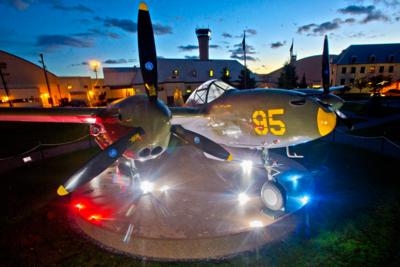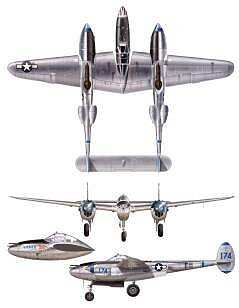Airplane Had Been Stripped And Abandoned In The Aleutian Islands
Flying through a January sky in 1945, U.S. Army Air Forces 2nd Lt. Robert Nesmith was piloting a P-38G Lightning - one of the Air Force's best aircraft during World War II. The plane, equipped with two engines and relatively long wings, was a beautiful sight, and Nesmith worked hard to be in a position to fly it across the Pacific.

The U.S. Army Air Forces accepted the P-38G from the manufacturer, paying $98,441.00 for it. The plane arrived at Elmendorf Field, Alaska, and was assigned to the 54th Fighter Squadron. "It was one of the most significant aircraft in World War II," said Joe Orr, the 673rd Air Base Wing senior historian. "The Germans hated it; the Luftwaffe called it the 'fork-tailed devil,' and the Japanese called it 'two planes, one pilot.' It was small enough to be very agile. It had two engines, so it had the power to go really fast, and once they put turbochargers on the engines, they could go higher and faster than most enemy aircraft."
That wasn't the only advantage possessed by the P-38. "They had long range as well because the wingspan was big enough to put drop tanks with more fuel on there and get some distance," Orr explained. "They were used all over the Pacific, from island to island, because of their reach. That made the P-38 desirable for Air Force operations, and especially here in the Aleutians where a 1,200 mile mission was the norm.
After the Japanese left Attu Island and U.S. forces recovered the islands, the land was used to fly missions into northern Japan. Nesmith was returning from a training mission, crossing over Attu Island, when something went wrong. The aircraft's left propeller fluctuated while flying low in Temnac Valley. "I was getting -- not serious -- but a little fluctuation," Nesmith said. "I had really pushed things down and it was real low." Both propellers contacted the ground. The plane bounced back up approximately 100 feet before Nesmith managed a successful wheels-up landing on the snow-covered valley.
Unharmed, the pilot surveyed the damage. It was well beyond repair. "It was not in an accessible area," Orr said. "In order to get to it, you had to hike to it. They didn't have heavy-lift helicopters that could pick it up and bring it back. Maintenance crews just stripped it of what wasn't damaged and left the rest there," he said. "They essentially just abandoned it in place; it sat there for more than 50 years."
The plane crashed in the Aleutian Islands which are property of the U.S. Fish and Wildlife Services, so the Air Force had to work with the agency to recover the plane.
Orr said the process of getting permission to have the last P-38G Lightning on Joint Base Elmendorf-Richardson was almost as difficult as restoring the one-of-a-kind aircraft's outside appearance. Capt. Steve Morrisette, a 54th Fighter Squadron pilot in 1998, contacted Don Delk and Ed Lamm, 3rd Wing civilian employees with a combined experience of 70 years, to head the team that actually went to the island and brought the plane back. Lamm -- considered the expert on structural repair -- was responsible for restoring all the base static displays. Delk had the expertise of management and recovery of aircraft, and resources as the maintenance squadron officer. He had previously been part of recovery projects for crashed F-15 Eagles and the E-3 Sentry that crashed on Elmendorf in September 1995.

"(The P-38) was in sad shape," Delk said. "Even though it had been beaten up pretty severely by the salvage crew and chopped up with crash axes to remove components and such, it had a good bit of corrosion, but not as much corrosion as we would expect being this close to the ocean. So for the number of years it laid out there, we thought it was in pretty fair shape."
They worked in "The P-38 Shop" in Hangar Four in 1998. McCloud died that year, leaving many concerned that the project would die with him. Brig. Gen. Scott Gration, the 3rd Wing commander at the time, picked up the direction and supported the work. "I estimate between the trip to Attu and the whole works, the recovery and restoration, we probably spent on the order of a couple hundred thousand dollars," the restoration expert explained. "That is cheap, dirt cheap for this type of restoration; downtown probably would have taken me at least $500,000 and two or three years."
In March of 2000, the 3rd Wing awarded a $223,256.70 contract to build the McCloud Memorial site where the P-38 was to be mounted. In July, the plane was put in its current and final resting place. "A P-38 was the first airplane in Alaska to score an aerial victory over a Japanese plane in World War II," Orr said proudly.
After the war, thousands of aircraft were melted down and recycled. Because it had been left on the island, the plane that Nesmith flew avoided that fate. The world's last example of a P-38G Lightning, though incapable of ever flying again, rests by the 3rd Wing headquarters building as a reminder of the power it and other P-38Gs were able to wield during World War II.
(USAF Images)
 ANN's Daily Aero-Term (04.30.24): Runway Centerline Lighting
ANN's Daily Aero-Term (04.30.24): Runway Centerline Lighting ANN's Daily Aero-Linx (04.30.24)
ANN's Daily Aero-Linx (04.30.24) Airborne 04.24.24: INTEGRAL E, Elixir USA, M700 RVSM
Airborne 04.24.24: INTEGRAL E, Elixir USA, M700 RVSM Airborne 04.29.24: EAA B-25 Rides, Textron 2024, G700 Deliveries
Airborne 04.29.24: EAA B-25 Rides, Textron 2024, G700 Deliveries Airborne-NextGen 04.23.24: UAVOS UVH 170, magni650 Engine, World eVTOL Directory
Airborne-NextGen 04.23.24: UAVOS UVH 170, magni650 Engine, World eVTOL Directory




